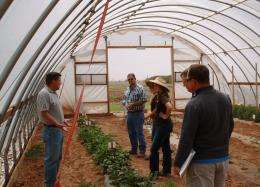High tunnels, mulch may be the answer to wild High Plains weather

Texas High Plains gardeners know that Mother Nature often doesn't play fair, but a Texas AgriLife Extension Service vegetable specialist at Lubbock is studying ways to even the odds.
Dr. Russ Wallace said high tunnels, coupled with biodegradable mulch, may make the difference between success and failure for small commercial vegetable operators plagued by the region’s high winds, hail and roller coaster temperatures. Wallace is half way through a three-year study on both technologies and feels they’ll be viable options for serious West Texas gardeners.
“High tunnels have been used for years in other parts of the world, but are new to the Texas High Plains,” Wallace said. “They look much like plastic covered Quonset hut-shaped greenhouses with roll-up sides. The big differences are that the structures are not heated or humidified and the crops grow in raised beds or directly in the ground.”
Wallace said high tunnels are used to increase yield, extend early and late production, and protect the crop from extreme weather, which he said is perhaps their most attractive virtue.
Wallace said small farm equipment is used for soil preparation and efficient drip irrigation provides water to the crop.
The mulch study compares various types of biodegradable mulches that warm the soil in early spring, cool it in hot weather, prevent weed growth and retain moisture throughout the season.
“The biodegradable mulches are being used in place of traditional polyethylene plastic because they break down naturally after one season,” Wallace said. “Because they break down, there’s not the added labor, expense and frustration involved with removing large, partially buried sheets of plastic.”
It’s still early in the study to know which of the biodegradable mulches is best, but Wallace said whether it’s paper or plastic, the new materials even now are a useful addition to any West Texas gardeners’ technology toolbox.
“Both aspects of this work, the high tunnels and the mulch study are looking very promising thus far, but their long-term cost effectiveness is still yet to be seen,” he said.
“At the completion of the study though, we should have solid answers for anyone considering these techniques on a small commercial level.”
Provided by Texas A&M AgriLife



















